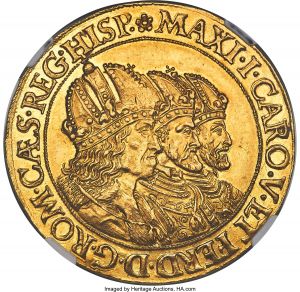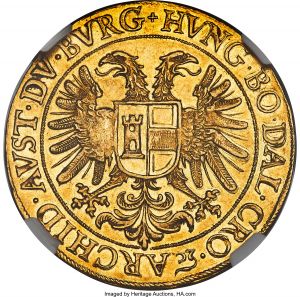Difference between revisions of "Bohemia (1612-19) 5 ducats Fr-14e"
m (Text replacement - "* [[Bohemia (1612-19) 2 thaler Dav-3065" to "* (1612-19) double thaler, Prague mint, three emperors, bust obverse * [[Bohemia (1612-19) 2 thaler Dav-3065") |
(deleted category) |
||
| Line 34: | Line 34: | ||
* [[Coins and currency dated 1612]] | * [[Coins and currency dated 1612]] | ||
| − | [[Category:Selections from Heritage sale 3096]][[Category: Gold ducats of Europe | + | [[Category:Selections from Heritage sale 3096]][[Category: Gold ducats of Europe]] |
Latest revision as of 08:53, 8 September 2025
This specimen was lot 30130 in Heritage auction 3096 (Dallas, TX, March 2021), where it sold for $408,000. The catalog description[1] noted,
"Austria: Virtually Immaculate "Three Emperors" 5 Ducat. Bohemia - Matthias II gold "Three Emperors" 5 Ducat ND (1612-1619) MS63 NGC, Prague mint. Benedikt Huebmer (?) as mintmaster. Struck from Taler dies (cf. Voglhuber-120/II). A coin whose enviable survivorship over the last 400+ years is almost unbelievable, even under close in-hand inspection. The surfaces are essentially immaculate, with Prooflike reflective brilliance that washes over the expanses. Flatness, an under-expression of detail are virtually absent, save for a spot of weakness on Maximilian's crown. Few locatable examples seem to have come to auction in recent decades, with perhaps the nearest contender being the plate coin in Friedberg, though no indication is provided as to the weight of that specimen. As such it is not at all improbable that this offering may be among the finest extent, and at the very least, seems to warrant a finer technical grade. The date surrounding the production of the "Three Emperors" (Dreikaiser) series with the busts of Maximilian I, Charles V, and Ferdinand I looking right is not fully agreed upon. From historical records, Halacka has argued against the traditional attribution of the type to the reign of Matthias II, instead suggesting that these were commemoratives for Rudolf II's coronation as Emperor. Zacharias Kempf, former die cutter at the Joachimsthal mint, was forced to leave his position for health reasons in 1590, receiving a pension of 15 Groschen per week. When approaching Emperor Rudolf, who resided in Prague for his entire reign, for a raise, he further sent along the dies for these coins. While Matthias would later use the same obverse dies on his coronation talers (cf. Dav-3064), which carried his portrait and name, it is indeed true that the transition from the previous Three Emperors type (cf. Dav-8105) had brought with it a change in the design of the crowns so that they featured a mitred style, in keeping with the structure of the famous crown of Rudolf II. From the Paramount Collection."
Recorded mintage: unknown.
Specification: 17.5 g, 0.986 fine gold, this specimen 17.32 g.
Catalog reference: KM 141 (Rare), Fr-14e (Rare), Horsky-1220 var. (under Rudolf; there, with rosette initial mark on reverse), Donebauer-1890 var. (under Matthias; there, with rose initial mark on reverse), Markl-1950 var. (same), Dietiker-552, Halacka-Type 2.
- Cuhaj, George S., and Thomas Michael, Standard Catalog of World Coins, 1601-1700, 6th ed., Iola, WI: Krause Publications, 2014.
- Friedberg, Arthur L. and Ira S. Friedberg, Gold Coins of the World, From Ancient Times to the Present, 9th ed., Clifton, NJ: Coin and Currency Institute, 2017.
- Craig, William D., Germanic Coinages: Charlemagne through Wilhelm II, Mountain View, CA: 1954.
- [1]Bierrenbach, Cristiano and Warren Tucker, Heritage World and Ancient Coins Auction 3096, featuring the Paramount Collection of World & Ancient Coins, Dallas, TX: Heritage Auction Galleries, 2021.
Link to:
- 1611 thaler, Prague mint
- 1611 double thaler, Prague mint
- 1612 quarter thaler, Joachimsthal mint
- 1612 thaler, Prague mint
- (1612-19) thaler, "three emperors," Prague mint
- (1612-19) double thaler, Prague mint, three emperors, bust obverse
- (1612-19) double thaler, "three emperors," Prague mint
- (1612-19) thaler, "three emperors," Prague mint
- 1613 thaler, Kuttenberg mint
- 1613 double thaler, Kuttenberg mint
- 1621 10 ducats, Prague mint
- 1633 5 ducats, Prague mint
- 1633 10 ducats, Prague mint
- Coins and currency dated 1612

